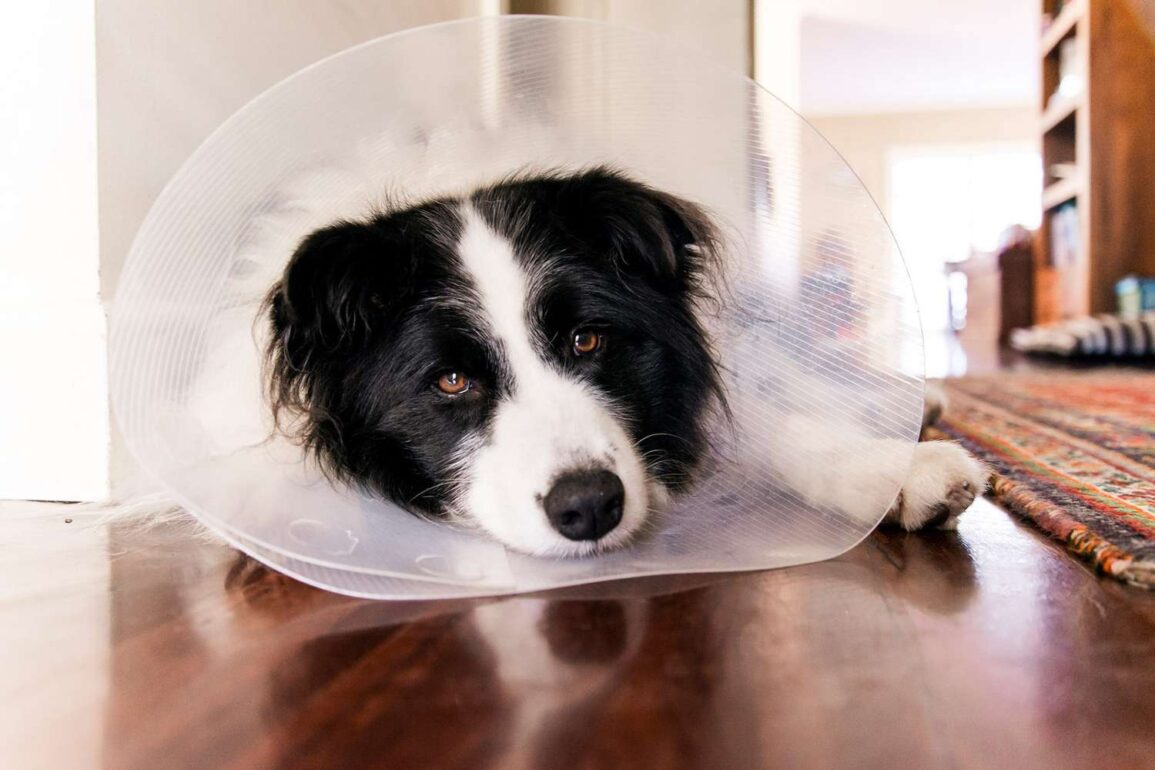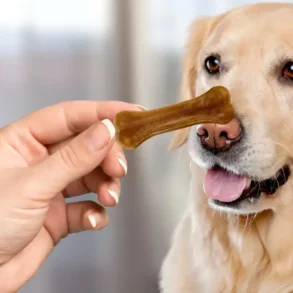
It’s inevitable. Your dog will likely need to wear an Elizabethan collar—also called the E-collar or the “dog cone of shame”—at some point in her life. As funny as they look, dog cones serve an important purpose. We talked to a vet to get all the info you need about dog cones, including when your dog will need one (it’s not just after surgery), how to pick the right size cone for your dog, how to get your dog ready for the cone, and alternatives if the cone is just not for her.
Why Dogs Need to Wear a Cone
“We put cones on animals to prevent them from chewing or scratching at an incision or a spot that we are trying to get to heal,” says Sara Ochoa, DVM, at Whitehouse Veterinary Hospital in Whitehouse, Texas. “Cones are important to keep your pet from causing any problems with their skin or surgical site. Some pets will easily make things much worse for them and even remove stitches from a surgical site, causing major complications.”
Ochoa says she also recommends a dog cone if the dog is scratching or itching excessively at a specific spot, regardless of whether they’ve had surgery.
Cone sizes vary based on the size and length of a dog’s face. “You want a dog cone to extend out 3–4 inches beyond the tip of their nose,” Ochoa says. “Pugs could actually have one that’s smaller than a dog that’s even their same size just because their faces are so small. And then you get a Doberman with a really, really long nose. They have to have one that’s even longer than a lab needs.”
How to Prepare Your Pooch for a Dog Cone
If possible, it’s a great idea to pick up a dog cone at your vet’s office before surgery and let your dog adjust to it gradually. Ochoa says it will take about two to three days for the dog to adjust. When your dog is wearing the cone, give them treats to create a positive association. Plus, give them grace.
“Be patient with them,” Ochoa says. “They get there. But it takes a while.”
Ochoa also suggests prepping your space for a cone-wearing canine. Even the most well-behaved dog could wreak havoc at home while wearing a cone. “I’ve had dogs break lamps,” Ochoa says.
How to Put On a Dog Cone
It’s likely your vet will put the dog collar on your pooch during your visit, but just in case, here are Ochoa’s steps to put a dog cone on securely:
- Untie the strings holding the cone together.
- Put the cone over the head like you would if you were putting on a shirt.
- Check that your dogs’ ears are inside the cone.
- When you tighten the cone, you want to make sure two to three fingers can fit between the rim and your dog’s neck. The cone should be tight enough to stay on without causing the dog discomfort.
When Can the Dog Cone Be Removed?
A dog cone should stay on for about a week. “Usually about seven to ten days is all you need,” Ochoa says. The cone needs to stay on the entire time the dog is healing, especially if you won’t be around 24/7 during the healing process to watch her.
You can consider taking the cone off temporarily during walks or using a longer leash until the dog becomes spatially aware of what’s around them while wearing the cone.
Always check with your vet before permanently removing the dog cone to make sure it’s ok to do so. “Make sure everything’s healed,” Ochoa says.
Note: The cone will be on long enough that you’ll need to clean it. Use soap and water on a rag and periodically wipe it down to avoid funky smells.
Alternatives to the Plastic Dog Cone
Ochoa has seen dogs repeatedly run into walls and tables to break their cones and ultimately escape them. “If your dog has anxiety or is jumpy or doesn’t do well with people rubbing their face, it’s probably best to look at alternatives, and ask your vet if they have any options,” Ochoa says.
Here are some of the most popular plastic dog cone alternatives:
Inflatable collars
Inflatable collars resemble neck pillows and are a softer option than the traditional cone. As the name suggests, you inflate them. Many animal health pros like inflatable collars because they are a more comfortable for the dog and less destructive—no accidentally hitting a lamp on an end table.
“The bigger the dog, the more I recommend [inflatable collars] because big dogs are going to tear up the plastic cones,” Ochoa says. Smaller dogs with smaller cones are less likely to unintentionally cause damage to the home.
Neck Collars
Neck collars are similar to the cervical neck braces a human might wear. They’re smaller and softer than a traditional cone and just wrap around the neck. “I’ve seen a few people use those, and they work really well,” Ochoa says.
Soft Collars
Soft collars are usually made out of fabric and are, as the name suggests, softer than a dog cone. One of the biggest disadvantages of soft collars is that your dog can’t see through them, making it difficult for the dog to walk around with these on.
Surgical Recovery Suit
The surgical recovery suit is a large piece of fabric that covers the majority of the dog’s body and can be a good option if your dog can’t stand to have anything on her neck. Plus, they come in an array of colors and sizes so you can order a cute one for your pup.
To make a homemade recovery suit, try using an old t-shirt. Cut the shirt in half, then cut out four holes for your dog’s legs. Create ties on either side of the shirt so you can put it on your dog and then tie it closed. You can use any shirt that will cover the wound or itchy area and prevent your dog from licking at it.
You can make your own dog cone, too. Ochoa says she had one pet parent use a pool noodle to create a neck collar, while others have created homemade cones out of t-shirts and socks.
This post was originally published on this site be sure to check out more of their content.








































